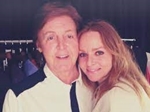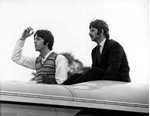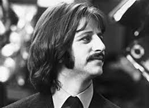- Register
- Log in to Tune-In
- Wishlist (0)
-
Shopping cart
(0)
You have no items in your shopping cart.
Beatles News

An artist who designed an early unused logo for The Fab Four in 1962 was shocked the learn the value of his sketches after not being paid by the band.
The designer of the first ever Beatles logo joked he'll "finally get paid" after having his sketches valued on the Antiques Roadshow.
The guest on the BBC show revealed the band asked him to design a logo for their drum when Ringo Starr joined The Beatles in 1962.
The band eventually dropped the design - featuring beetle antennae on the letter 'B' - choosing the now famous logo designed by Ivor Arbiter instead.
Source: Albertina Lloyd/news.yahoo.com
details
The renowned fashion designer experienced a “double celebration” as it was not only Father’s Day but also the 81st birthday of iconic musician and father figure, Sir Paul McCartney.
Expressing her gratitude on Instagram, she wrote: “My father has been by my side every step of the way, offering advice, support, and most importantly, love. While the world sees him as an icon, on this day of double celebration, I simply call him Dad.
“To me, he is my rock. My rock ‘n roll rock! I love you and will always love you. Thank you for making my life better each and every day.
“On this special day, let’s also celebrate all the brave and amazing fathers out there, including those in the Stella family. Stay kind and always show love… x Stella.”
Source: vigourtimes.com
details
Daniel Ellsberg performed many feats during his 92-year life: collecting the Pentagon Papers, fighting against nuclear proliferation and helping to bring down a president.
He also got three of the four Beatles to help pay his lawyers.
Ellsberg’s decision to leak the Pentagon Papers — 7,000 pages of secret documents that exposed the U.S. government’s knowing deception about the Vietnam War — led the government to indict him on espionage charges in 1971, a legal saga that led in part to revelations that undid Richard M. Nixon’s presidency.
As the trial progressed, Ellsberg, who died Friday, was running out of funds for his defense.
That’s where Barbra Streisand, the Beatles and other celebrities came in.
Streisand and activist Stanley K. Sheinbaum, who organized Ellsberg’s defense fund, decided to hold a fundraiser on Ellsberg’s 42nd birthday in April 1973. The singer invited scores of celebrities, including John Lennon, George Harrison and Ringo Starr, who paid $250 each to attend, the Associated Press reported. The party marked the first public event featuring three of the four Beatles since the band’s 1969 breakup.
Source: She details

When The Beatles broke up, Ringo Starr, George Harrison, and John Lennon were on one side of the divide, while Paul McCartney was on the other. McCartney sued the band in order to wrest control from manager Allen Klein. The split and legal battle meant the dynamic between the former bandmates was a stormy one. Starr wanted to maintain a friendly working relationship with his former bandmates, though. While he trusted that Lennon and Harrison would continue collaborating with him, he didn’t know if McCartney would.
After the death of longtime Beatles manager Brian Epstein, the band hired Klein. McCartney wasn’t happy with this decision, though. He wanted to hire Lee Eastman, his father-in-law, something the rest of the band stood firmly against. These business dealings muddied their musical relationship, and by 1970, they had announced their breakup.
Afterward, McCartney sued the band to take control of their catalog from Klein. This did further damage to the relationship between the former bandmates. Despite all this, Starr wanted to maintain a musical relationship with each of the ex-Beatles. In the song “Early 1970,” he expressed this, as well as his worry that McCartney would want noth details

Paul McCartney used his Pentax camera the same way he used his guitar: with total freedom. And in early 1964, the 21-year-old took his new camera on perhaps the most momentous musical journey of the 20th century: The Beatles' invasion of America.
Hundreds of photographs from that trip were recently rediscovered in McCartney's archive: "It was really nice," he said, "because I thought they were lost."
The images, collected in the new book, "1964: Eyes of the Storm," will be on view later this month at the National Portrait Gallery in London.
He offered a tour of the exhibit to correspondent Anthony Mason.
McCartney explained his process: "Taking photographs, I'd be just looking for a shot. And so, I'd aim the camera and just sort of see where I liked it, you know, oh, that's it. And invariably, you pretty much take one picture.
Source: Anthony Mason/ details

The Beatles and The Beach Boys were rivals in the 1960s, but their competitive nature often led to the bands directly influencing each other1967’ Sgt. Pepper’s Lonely Hearts Club Band is still The Beatles’ best-selling album. It was also their most experimental, as the band took on new personalities and dived deep into rock psychedelia. While the album saw the band at their highest peak creatively, it owes a lot to another project. According to producer Giles Martin, son of Beatles’ producer George Martin, Sgt. Pepper’s would not have happened without an album from The Beach Boys.
Source: Ross Tanenbaum/cheatsheet.com
details
Ringo Starr held out hope that he would perform with his Beatles bandmates again. He wrote a song expressing this hope.In 1970, The Beatles publicly announced their break up, and Ringo Starr wrote a song about his former bandmates. In each verse, he sang about his bandmates and wondered about the likelihood of them playing music with him. By the end of the song, he expressed his earnest hope that they’d all collaborate again. The song functioned as an open letter to the ex-Beatles, but Starr never truly had much cause for concern.
began working on their solo careers. Starr’s first solo single, “It Don’t Come Easy,” came out in 1971. The B-side of this single was the song “Early 1970.” In it, Starr addressed each of his bandmates in turn.
Source: Emma McKee/cheatsheet.com
details
Ringo Starr said The Beatles used drugs, just not in the studio. He explained that they learned this the hard way early in their career.Over the years, John Lennon, Paul McCartney, George Harrison, and Ringo Starr all spoke candidly about the way drugs impacted The Beatles’ music. They released albums that were heavily influenced by different substances, and they each felt that drugs helped open their minds. Despite this, Starr claimed that they never used drugs while in the studio. He believed this would have had a negative impact on their music.
After Bob Dylan introduced The Beatles to marijuana in 1964, they began frequently using drugs. Lennon described Rubber Soul as their “pot album,” and LSD had a large influence on their work in the latter half of the 1960s. After Lennon and Harrison tried it, they encouraged McCartney and Starr to use it as well.
“I’d take anything,” Starr said, per Rolling Stone. “It was a fabulous
Source: Emma McKee/cheatsheet.com
details
Cynthia Lennon was not a fan of George Harrison when he was 15 and she was 20. He was the last person she wanted to visit her in the hospital. When George Harrison started playing music with John Lennon, he was 15 years old. Cynthia Lennon (Powell at the time), John’s then-girlfriend, was about 20. She thought of him as an annoying kid brother. When she got her appendix removed, he was the last person she wanted to see in her hospital room. According to the Beatles biography The Love You Make by Peter Brown and Steven Gaines, George was “the friend of John’s that Cynthia liked the least.” He had a way of annoying her. A big part of that was the amount of attention he gave to John.
Source: Kelsey Goeres/cheatsheet.com
details
George Harrison has many philosophical inspirations for his music, but he was inspired to write ‘While My Guitar Gently Weeps’ from a less complex sourceGeorge Harrison’s “While My Guitar Gently Weeps” is one of the best songs he wrote for The Beatles. He didn’t write many hits for the fab four, but this White Album song is one of his highlights. While this track would take many writers years to think up, Harrison found inspiration for it relatively quickly. Harrison didn’t write many hits for The Beatles, as most songwriting duties fell to Paul McCartney and John Lennon. However, when he did get the opportunity to write, he shined. A few of his tracks, like “Something” and “Here Comes the Sun”, remain classic hits in The Beatles’ discography.
Source: Ross Tanenbaum/cheatsheet.com
details
Some 54 years after its release on the iconic Abbey Road album, those lyrics still ring true for a legion of Beatles fans and perhaps especially for Hampton’s Ken Lambert.
On a bit of a whim, Lambert purchased the childhood home of Beatles legend George Harrison in an auction in November 2021. He has since seen Beatles fans from across the world come together in the modest abode at 25 Upton Green in Speke, a suburb of Liverpool, to celebrate Harrison and the Beatles.
A longtime Beatles fan, Lambert said it’s the people he has met along the way during this year-and-a-half magical mystery tour of sorts, along with the effusive reviews, that have made it worthwhile.
Source: seacoastonline.com
details
Paul McCartney recognizes that John Lennon lived a “really tragic life” and he admires the way his bandmate dealt with it.
The late Beatles star endured a challenging childhood and continued to encounter difficulties in later years, his bandmate and co-songwriter said at the Tribeca Film Festival.
He and Conan O’Brien were discussing photos from McCartney’s new book 1964: Eyes of the Storm. O’Brien selected an image of Lennon seated in the back of a car around the age of 23, saying it carried an air of anxiety and vulnerability. “I don’t know about the anxiety, but the vulnerability is very true,” McCartney replied.
1964: Eyes of the Storm contains nearly 300 pictures taken by McCartney as the Beatles rose to superstardom. He thought he’d lost the trove of shots long ago, before they were rediscovered. “What I love about them is the innocence,” McCartney said. “We didn’t know we were going to get famous. We really wanted to be, but we didn’t know.”
Source: wbsm.com
details
Guitar lessons: Before the chemical-fuelled studio experimentation of their psychedelic ‘middle’ period, The Beatles were a remarkably well-honed hit machine.
Their live-in-the-studio performances were tight, and their songwriting chops even tighter – they reeled off hits with remarkable sophistication for songwriters in their early 20s, with a work ethic that puts modern bands to shame.
With John Lennon locking down the rhythm, George Harrison’s instantly recognisable melodic lead guitar drew on 1950s influences including Chuck Berry and Carl Perkins, while his early adoption of the Rickenbacker 12-string guitar introduced the world to a sound that is now synonymous with the vocabulary of 1960s pop.
Read on for 10 timeless guitar lessons we can learn from John and George as they burned their names into the musical history books and gained the adoration of millions.
Source: Total Guitar/musicradar.com
details
Paul McCartney has many memories of George Harrison and John Lennon and he often thinks about them to keep their spirits alivePaul McCartney often reminisces about George Harrison and John Lennon. While Ringo Starr is also like a brother to him, Harrison and Lennon grew up with McCartney, and the trio developed plenty of fantastic memories. While Harrison and Lennon are no longer here, McCartney still has many ways to remember his former bandmates and friends. Paul McCartney recently opened an exhibit at the National Portrait Gallery that featured pictures he discovered of The Beatles during the height of Beatlemania in 1964. He also recently released a book featuring these photos called 1964: Eyes of the Storm. In a recent interview about the book with BBC Radio 4’s Today, McCartney shared his thoughts when he sees photos of Lennon and Harrison.
Source: Ross Tanenbaum/ cheatsheet.com
details
The watercolour painting of Lennon has been given a pre-sale estimate of £20,000. A portrait of John Lennon by his close friend and former bandmate Stuart Sutcliffe is to be sold at auction.
The pair met when they were both students at Liverpool College of Art and Sutcliffe was The Beatles' original bass guitarist, but he quit in July 1961 to focus on his art career.
The watercolour by Sutcliffe, who died in April 1962, is thought to be his only portrait of Lennon.
Chorley-based Tracks Auctions has given it a pre-sale estimate of £20,000.
The auction house said the work was painted by Sutcliffe in 1961 or 1962 at his studio in the attic of his girlfriend Astrid Kirchherr's family home in Hamburg.
A portrait of Kirchherr by Sutcliffe has also been included in the sale, with a similar auction estimate.
Source: BBC News/bbc.com
details